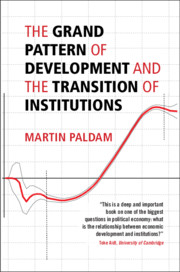Book contents
- The Grand Pattern of Development and the Transition of Institutions
- The Grand Pattern of Development and the Transition of Institutions
- Copyright page
- Contents
- Figures
- Tables
- Preface
- Part I Main Ideas
- Contents
- 1 Introduction
- 2 Some Technical Points
- 3 The Largest Historical Event
- Part II The Transitions of Institutions
- Part III The Grand Transition
- References
- Index
2 - Some Technical Points
from Part I - Main Ideas
Published online by Cambridge University Press: 07 August 2021
- The Grand Pattern of Development and the Transition of Institutions
- The Grand Pattern of Development and the Transition of Institutions
- Copyright page
- Contents
- Figures
- Tables
- Preface
- Part I Main Ideas
- Contents
- 1 Introduction
- 2 Some Technical Points
- 3 The Largest Historical Event
- Part II The Transitions of Institutions
- Part III The Grand Transition
- References
- Index
Summary
A transition curve should have six properties. If all are present, the transition curve is termed beautiful. A beautiful transition curve becomes hump-shaped in first differences. A factor analysis of the main variables shows that they have one and only one joint factor, which is the Grand Transition. It is difficult to study by regression analysis, but it is possible to do so by using univariate kernel techniques using unified data samples ordered by income. This order scrambles other dimensions of the sample. Changes are caused by triggering events. Transition curves are attractors for changes in the explained variables. Four ways to establish the main causal direction are introduced; they include the DP-TSIV-test using the development potential as instruments. The objection that transition curves are statistical artifacts is rejected.
Keywords
- Type
- Chapter
- Information
- Publisher: Cambridge University PressPrint publication year: 2021

